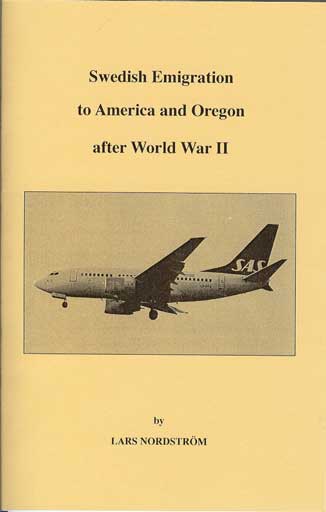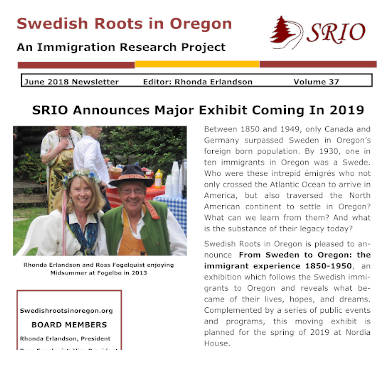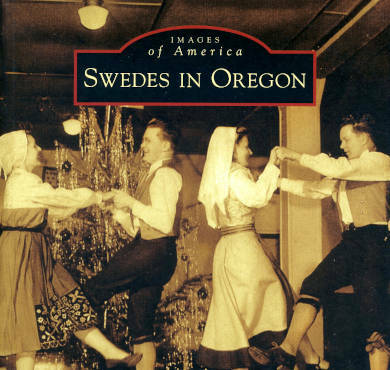By Lars Nordström, 2007
About this book
Introduction
Swedish emigration to the United States following World War II is not a widely studied subject, perhaps for the simple reason that it involves a relatively small number of individuals. Perhaps also because, in comparison to the foreign immigration to Sweden during the last couple of decades, this group is small indeed. If we want to understand the two distinct communities that have emerged in the United States during the last thirty years or so – the Swedish American community and the scattered groups of utlandssvenskar (expatriate Swedes) – it is helpful to take a broad look at the main currents in modern Swedish emigration.
Relying on various statistical sources and earlier research, this article surveys the general character of Swedish emigration following the end of World War II and attempts to answer the following questions: Where have Swedes emigrated to during this period? How many individuals make up this migratory flow? What is really meant by the term “a Swedish emigrant”? How reliable are official statistics in describing the fluid patterns of individuals moving from one country to another? What are the proportions between Swedes and Swedish-Americans in the state of Oregon today, and what is the size of Swedish immigration compared to other immigrant groups?
The second part looks into the main causes behind modern Swedish emigration to the United States. Perhaps a bit surprisingly, it finds that today it seems just as common to emigrate because one has fallen in love with an American as it does because one dreams of better opportunities and a higher standard of living.
The third part contains some personal observations on the nature and needs of the Swedish-American community in a state like Oregon, and compares them to those of the modern Swedish immigrants. It also describes how radically the Swedish immigrant experience in the United States has changed during the last 30 years, and how it has re-defined what it means to be a Swede living in America.
Lars Nordström, Ph. D.

Read an Excerpt
Why Leave Sweden for America Today?
Migration scholars often divide the underlying emigration causes into a combination of “push” and/or “pull” factors. “Push” is defined as various kinds of hardships – such as religious, ethnic, political, or economic persecution by a ruling class in the emigrant’s native country, or as a condition of extreme poverty or even starvation. “Pull” is primarily defined as an economic attraction: in a situation characterized by scant employment or financial opportunity (sometimes expressed as an inability to advance due to a rigid class structure), there is the promise of a better standard of living in the new country. Then, as an emigration movement develops, additional “pull” factors come into play. Ethnic enclaves in the new country become magnets that attract others belonging to that group, and members of divided families seek to re-connect with each other. Additional, and more recent, factors such as climate, livability, and “community values” also belong to the “pull” category, even if attractions like “community values” can be elusive and difficult to quantify.
The historical “push” causes can certainly be found behind most of the great migration of Swedes to the New World between 1840 and 1925. But in the second half of the 20th century they are not forces of the same magnitude, even though the economic “pull” of the United States still clearly is a determining factor for some emigrants, especially in certain professions. In the post-World War II period, Sweden emerged as an increasingly wealthy nation where hunger, poverty and social injustice had been mostly eliminated. Swedish citizens were offered a free and decent education (including university studies), universal healthcare, decent working conditions including statutory vacations, maternity leave and many other workers’ rights, and they had the opportunity to exercise a number of personal freedoms. Almost all could find employment, and even if one could not, there was a social safety net that fed, housed and clothed them.
If conditions in one’s homeland are good, it is only natural to ask why people decide to emigrate. In a recent study commissioned by the organization Svenskar i Världen, in which 1099 Swedish emigrants were interviewed, the largest group claimed that it was “the culture and quality of life in the new country [that] tempted [them].” Quite clearly a “pull” factor, and many Swedish immigrants to the United States during the last thirty or forty years have obviously been motivated by the economic pull. They are aware that their profession (such as entrepreneurs, high tech engineers, doctors, lawyers and researchers) pays better in the United States, taxes are lower, and this translates into a higher “quality of life.” According to the same study, the second biggest cause for emigration was “the high level of taxation / the tax system in Sweden.” Obviously this can be defined as a “push” factor that appears to be linked to ideological objections to the socialist policies of the Social Democrats, who have dominated Swedish politics during the postwar period. Finally, the third most common reason “was being offered a job abroad.” Some in this last category might not have intended to settle in the United States initially, but their working assignment gradually evolved into an emigration. (Perhaps it was due to unfavorable work-related changes in Sweden while working abroad, an appreciation of the quality of life in America, or a marriage to an American.) For others the emigration might have been an escape from something, or a desire for adventure (by those who found Sweden a bit too focused on security, stability, and predictability). There may also be subtle and unconscious reasons behind an emigration, such as fulfilling unrealized emigration dreams of a parent who, for a number of reasons, never had the opportunity to pursue it. It may seem a frivolous argument to claim that people emigrate simply to live in a warmer and sunnier climate, but there are indications that sun and warmth are at least part of the equation of where to live, especially among retirees. Referring to the Modern Language Association map again, we see that there are approximately 13,000 Swedish speakers in California, and almost 5,000 in Florida. And Swedes do not exactly flock to Alaska, where the latitude, seasons, climate, flora and fauna are very similar to that of Sweden, suggesting that today’s Swedish immigrants to the United States do not seek those particular familiar elements from home. (Today, there are only about 300 Swedish speakers in Alaska.)
But the emigrant discussed above, the person (or family) who actively leaves Sweden, whether “pushed or pulled,” might still not be typical of the majority of the Swedes living in the United States today. A larger group is clearly made up of individuals who fall in love with an American and simply “end up living” in the United States. They are what could be called “tag-alongs.” H. Arnold Barton claims that “after career opportunities the main motive for emigration would appear to be quite simply love. Widespread travel and study abroad among young people – together with the numerous [Swedish] au pair girls living in American families – have created far broader international contacts than ever before, often leading to romance and marriage. As the couple most typically settles in the husband’s country, this has resulted in a considerable number of Swedish-born wives of Americans living in the United States.” (As discussed earlier, the statistics confirm that there is a female majority among Swedish emigrants.) It should perhaps also be said that it is easier for a woman – both financially and ideologically – to stay home as a fulltime mother in the Unites States than in Sweden, if that is an important value to her.
In his analysis of the 1990 Census, David E. O’Connor states “that of the 53,676 Swedish-born Americans, the West claimed the highest number with 18,954 (35.3 percent).” Of the three Western states, Oregon ranked last after California and Washington – but then it also has the smallest population of the three (California has approx. 34 million, Washington 6 million, and Oregon 3.6 million inhabitants). Even though Oregon in many respects is a Janus-faced culture both looking east, back toward Europe, and west, across the Pacific toward Asia, it is a place where Swedes seem to feel at home. Some aspects of the natural environment (snowy mountains, forests, rivers and a long coastline) are reminiscent of that in Sweden, and it has four distinct seasons. It is also an area where Swedes (and Scandinavians) have played a noticeable role in the local history, and where certain Swedish traditions like Midsummer and St. Lucia celebrations are still being observed. Oregon is also known to be (at least from an American point of view) a relatively liberal and progressive state.





